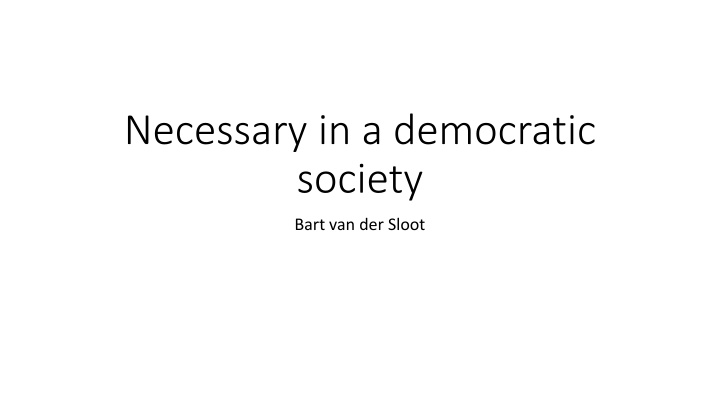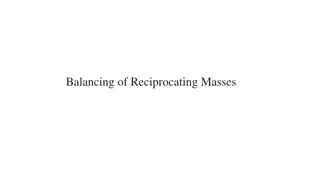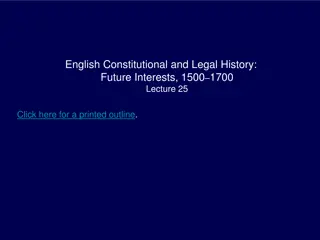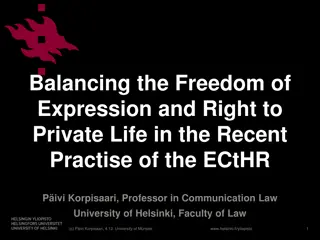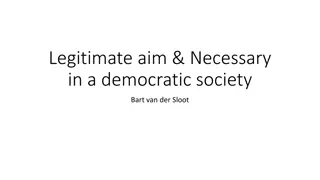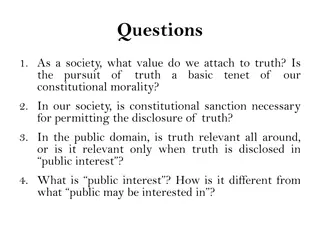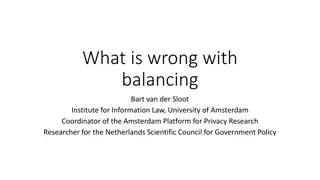Necessity Test in a Democratic Society: Balancing Public vs Private Interests
The necessity test in a democratic society involves balancing public interests such as security, morality, and environment against private interests. The test determines whether an infringement is necessary and legitimate, or unnecessary and a violation. Different categories like security-related cases, morality-based cases, and environmental cases are discussed regarding the weight of public interest. The focus is on ensuring national security and preventing crime, where the Court emphasizes the necessity of interference over private interests to achieve legitimate goals.
Download Presentation

Please find below an Image/Link to download the presentation.
The content on the website is provided AS IS for your information and personal use only. It may not be sold, licensed, or shared on other websites without obtaining consent from the author.If you encounter any issues during the download, it is possible that the publisher has removed the file from their server.
You are allowed to download the files provided on this website for personal or commercial use, subject to the condition that they are used lawfully. All files are the property of their respective owners.
The content on the website is provided AS IS for your information and personal use only. It may not be sold, licensed, or shared on other websites without obtaining consent from the author.
E N D
Presentation Transcript
Necessary in a democratic society Bart van der Sloot
Overview of lectures 26 September 2017 27 September 2017 3 October 2017 4 October 2017 > Ratione personae > Ratione materiae > Prescribed by law & Legitimate interest > Necessary in a Democratic Society & Special lecture by Claudia Quelle
Overview of today (1) Different tests (2) 10 Questions about balancing (3) Break (4) Claudia Quelle
(1) Different tests (1) Necessity test (2) Balancing (3) Pareto efficiency (4) In abstracto
(1) Different tests Thus, with regard to security-related cases, the public interest is weighed in terms of importance; with regard to morality-based cases, usually a wide margin of appreciation is granted to states, which is at the same time subjected to European supervision; and with regard to environmental cases, the public interest is mostly not weighed or assessed in detail, but rather assumed. The test of an infringement being necessary in a democratic society is a binary one. An infringement may either be necessary, in which case it is legitimate, or it may be qualified as unnecessary, in which case it violates the Convention. Although the Court still adopts this test with regard to a substantial number of cases relating to the protection of security, with regard to other matters it has often approached the question of necessity as a matter of proportionality or applies a fair balance test, in which the relative weight of the common and the private interest is balanced. Finally, although it refers to the fair balance of interests and the proportionality of interferences with regard to matters in which the economic rationale is invoked, in these cases the Court in fact primarily assesses whether an unreasonable burden has been imposed on an individual.
(1) Different tests Security With regard to ensuring national security, promoting public safety, preventing crime, and maintaining public order, the Court usually does not evaluate the private interests of the applicant. When states monitor behaviour, wiretap correspondence, enter homes, and confiscate private documents to prevent criminal activities, the Court does not so much weigh the private interests of the individuals involved, but focuses primarily on the necessity of the infringement. Under this model: the Court tends to concentrate on the factual necessity of the interference to the achievement of the legitimate purposes at stake, with the right giving way if necessity is accepted. [This] approach is most frequently adopted in cases where national security and prevention of disorder/crime defences are pleaded. That the Court is prepared to let these goals override individual rights is understandable because without a minimum level of national and personal security nobody's rights are safe. However, to allow interferences on these grounds beyond what is strictly necessary would be to sanction potential oppression. Consequently, the Court assesses whether the infringement has been necessary, whether the state has abused its powers, and whether it has infringed upon the rights and freedoms of its citizens in an arbitrary manner, and the Court must be satisfied that there exist adequate and effective guarantees against abuse . The assessment thus remains an intrinsic one and it stays at the level of the necessity of the public policy or state action as such.
(1) Different tests There are two important exceptions to the application of the necessity test in cases relating to security. First, with regard to prisoners, the necessity test is sometimes adopted, for example when the right to correspondence with, for instance, the Court has been unduly restricted, under which circumstances the Court has often simply considered that there were: no compelling reasons why the applicant's correspondence with the Court should have been monitored. It follows that, the interference complained of in the present case was not necessary in a democratic society within the meaning of Article 8 2.
(1) Different tests However, in relation to other matters, such as having regular contact with spouse and children, the Court adopts a balancing test and seems to assess the relative impact of an interference on a person's private and family life. Still, this balancing test is muffled in the sense that restrictions on rights and freedoms are precisely the essence of imprisonment and, subsequently, the Court has accepted that there are inherent and legitimate limitations on the rights of prisoners. Consequently, only in exceptional circumstances will a violation be found. Second, with regard to expelling criminal immigrants, the Court does adopt a full-fletched balancing test, identifying as relevant factors the nature and seriousness of the offence committed by the applicant, the nationalities of the various persons concerned, the length of the applicant's stay in the country, the time elapsed since the offence was committed, the applicant's conduct during that period, the applicant's family situation, such as the length of the marriage and whether there are children of the marriage, and if so, what their ages are, the best interests and well-being of the children particularly in relation to the seriousness of the difficulties which they and the spouse are likely to encounter in the country to which the applicant is to be expelled, whether the spouse knew about the offence at the time when he or she entered into a family relationship, and the solidity of social, cultural, and family ties with the host country and with the country of destination. Consequently, in relation to immigration policies for the prevention of disorder and crime, the Court adopts an elaborate and sophisticated balancing test in which it tries to weigh the relative impact of the expulsion on a person's private and family life with the relative general interest involved.
(1) Different tests 4.2. Morals In relation to the protection of morals, the balancing test of the Court in which the outcome of the case is determined by weighing the common with the private interest seems to be especially prominent. As explained in the previous section, the government is granted a wide margin of appreciation in relation to matters that have moral, cultural, and ethical implications, but this discretion is curtailed when an overriding European consensus exists. The margin of appreciation is curtailed even further if the private interest of an applicant is particularly substantial, and, not surprisingly, this is often the case with moral-based legislation. In Dudgeon, for example, the Court accepted a margin of appreciation for the government when protecting societal morals, but added that not only the nature of the aim of the restriction but also the nature of the activities involved will affect the scope of the margin of appreciation. The present case concerns a most intimate aspect of private life'.
(1) Different tests The Court has held as a standard principle that a difference in treatment is discriminatory if it has no objective and reasonable justification and the Court has repeatedly stated that just like gender based differences in treatment differences in treatment based on sexual orientation require particularly serious arguments by way of justification and particularly convincing and weighty reasons. In Goodwin, the Court likewise accepted that the: stress and alienation arising from a discordance between the position in society assumed by a post-operative transsexual and the status imposed by law which refuses to recognise the change of gender cannot, in the Court's view, be regarded as a minor inconvenience arising from a formality. A conflict between social reality and law arises which places the transsexual in an anomalous position, in which he or she may experience feelings of vulnerability, humiliation and anxiety. Moreover, in the medical sphere, where often a particularly important facet of an individual's existence or identity is at stake, for instance in terms of in vitro fertilisation, abortion, or euthanasia, the margin afforded to the state will normally be further curtailed, because of the substantial individual interest at stake.
(1) Different tests In conclusion, in cases in which morality plays a role, the margin of appreciation of states to adopt legislation in the common interest is especially wide, if not overruled by European consensus, and the private interest of the minority or individual affected by the legal regulation or policy is likewise particularly substantial. Consequently, in such cases, the Court adopts a balancing test in which it weighs the private against the public interest, the outcome of which often depends on the specific circumstances of the case, the specificities of the national moral environment, and the particular situation of the applicant. In cases where the Court only relies on Article 8 ECHR, it has commonly adopted as proportionality test whether the justifications for retaining the law in force are outweighed by the detrimental effects on the life of a person, either through practical effects or though the legal position itself. In cases in which both Article 8 and Article 14 ECHR are applied, the Court often adopts as an essential principle that in such cases: the principle of proportionality does not merely require the measure chosen to be suitable in principle for achievement of the aim sought. It must also be shown that it was necessary, in order to achieve that aim, to exclude certain categories of people [] from the scope of application of the provisions at issue.
(1) Different tests 4.3. Economic well-being With regard to cases in which economic rationales play a role, the Court does take into account the private interest of the individual, but this interest is often less substantial than in cases which concern morality- based legislation. For example, in Hatton, the Grand Chamber held that although the night flights had obvious consequences for the applicants: the sleep disturbances relied on by the applicants did not intrude into an aspect of private life in a manner comparable to that of the criminal measures considered in Dudgeon to call for an especially narrow scope for the State's margin of appreciation. Rather, the normal rule applicable to general policy decisions would seem to be pertinent here, the more so as this rule can be invoked even in relation to individually addressed measures taken in the framework of a general policy.
(1) Different tests The test applied in these cases is neither a necessity test nor a balancing test, but the focus lies on the question whether an individual or a particular group in society bears an unreasonable burden as a consequence of the policy adopted. Again, this seems to be transposed from the Court's case law concerning social-economic policies and matters regarding the right to property, in relation to which the Court has adopted as a general principle that a: fair balance must be struck between the demands of the general interest of the community and the requirements of the protection of the individual's fundamental rights, the search for such a fair balance being inherent in the whole of the Convention. The requisite balance will not be struck where the person concerned bears an individual and excessive burden.
(1) Different tests This test differs from the two previous tests in that it does not focus solely or primarily on common interest and public policy, as with regard to infringements legitimated by their instrumentality towards ensuring safety. Neither is a particular balance struck between the private and the public interest involved with a certain infringement, such as with legal regulations and policies grounded in societal morals. Economy-based matters are primarily approached by the Court by determining the specific private interest and the particular effect of a situation or policy on a specific group of persons. Thus, although the public interest and the general policy are not questioned as such, the Court determines whether in a specific case an exception has to be made or a special treatment has to be provided to people or groups bearing an unreasonable burden. In Gillow, for example, an applicant submitted two claims, one of a more general and abstract nature, aimed at the legal provisions as such, and the other concerning the application of the legal rules in his specific situation. Although the Court held that the statutory obligation imposed on the applicants to seek a licence to live in their home cannot be regarded as disproportionate to the legitimate aim pursued , it continued to hold that there remains, however, the question whether the manner in which the Housing Authority exercised its discretion in the applicants case refusal of permanent and temporary licences, and referral of the matter to the Law Officers with a view to prosecution , with respect to which the Court found a violation as far as the application of the legislation in the particular circumstances of the applicants case was concerned'.
(1) Different tests Similarly, this test is apparently adopted with regard to positive obligations. For example, the case of L. v. Lithuania (2007) did not regard the request to alter and acknowledge the newly adopted gender, as in most cases regarding transsexualism. Rather, the applicant claimed that the state had failed to provide him with a lawful opportunity to complete his gender reassignment and obtain full recognition of his post-operative gender. Although the Lithuanian law recognised the right to change not only one's gender but also one's civil status, there was no law regulating full gender reassignment surgery. This had the effect, according to the Court, that the applicant found himself in the intermediate position of a preoperative transsexual, having undergone partial surgery, with certain important civil status documents having been changed. The Court finds that the circumstances of the case reveal a limited legislative gap in gender reassignment surgery, which leaves the applicant in a situation of distressing uncertainty vis- -vis his private life and the recognition of his true identity. Whilst budgetary restraints in the public health service might have justified some initial delays in implementing the rights of transsexuals under the Civil Code, over four years have elapsed since the relevant provisions came into force and the necessary legislation, although drafted, has yet to be enacted. Given the few individuals involved (some fifty people, according to unofficial estimates []), the budgetary burden on the State would not be expected to be unduly heavy. Consequently, the Court considers that a fair balance has not been struck between the public interest and the rights of the applicant.
(1) Different tests Thus, given the fact that such a small group had to bear such a heavy burden was ruled undesirable by the Court; the state had to make alterations to its policy and provide relief to the victims. With regard to environmental issues, the Court has held as a principle that the onus is on the State to justify, using detailed and rigorous data, a situation in which certain individuals bear a heavy burden on behalf of the rest of the community . Consequently, states have the obligation to ease the situation of those directly affected by aircraft noise, air pollution, and smog, for instance by providing adequate and just compensation or by facilitating their migration to another part of the country. Thus, although the general policy is not questioned and left intact, when it places an unreasonable burden on a specific person or group, this burden should be relieved or compensated. Finally, with regard to immigration control in the economic interest, the Court does not weigh the economic interest involved against the individual interest, but rather determines whether in the particular circumstances of the case, an exception should be made to the general, in itself legitimate, policy. For example, when the Dutch government decided to expel an immigrant which decision would seriously affect her and the ties with her child who had not pursued to regularise her stay in the Netherlands until more than three years after first having arrived in that country and whose stay there had been illegal throughout the entire period, the Court held that by attaching such paramount importance to this latter element, the authorities may be considered to have indulged in excessive formalism'. Thus, although the policy was deemed legitimate in itself, the application of the regulation in this particular case placed an excessive burden on the claimant.
(1) Different tests SATAKUNNAN MARKKINAP RSSI OY AND SATAMEDIA OY v. FINLAND JUDGMENT It is for the Court to decide whether to apply a balancing approach or to apply the test of necessity. Hitherto this Court has applied either one or the other never both, contrary to today s judgment. While, according to prevailing case-law, balancing between two Convention rights requires the Court to defer to national choices, both the conflicting rights must still be given proper consideration (i.e. the Court must exercise its own scrutiny where one right is simply declared decisive without proper reasons). However, in the present case, when performing the balancing test, the domestic courts failed to take proper account of both rights at stake, and this Court did not even consider the matter, even though it is required to do so by its case-law. In cases where the balancing exercise carried out by the domestic court excluded any of the requisite considerations, the Court must find a violation. This Court s case-law requires proper consideration of the following factors, among others.
(1) Different tests Delfi Necessity test Balancing act (1) The Court discusses whether Delfi can invoke a right to freedom (1) Delfi invokes the right to freedom of expression, as provided of expression under Article 10 ECHR (2) The Court assesses whether the fine Delfi had to pay is a (2) L. invokes his right to reputation, as provided under Article 8 limitation of its right ECHR (3) The Court determines whether this limitation is prescribed for (3) The Court grants a wide scope to both provisions and gives no by law and foreseeable principled priority of one right over the other (4) The Court checks whether the limitation serves a legitimate (4) The Court balances the two rights against each other, setting out interest certain ad-hoc criteria (5) The Court determines whether the limitation in law as such is (5) The Court only discusses the particularities of the case, taking necessary in a democratic society, for example, whether it serves a into account all relevant circumstances pressing social need
(1) Different tests Necessity test Balancing act (1) The Court discusses whether Stadtsparkasse could invoke the banking secrecy; (1) Coty s claim is understood as referring to the right to intellectual property, as provided under 17.2 Charter (2) The Court assesses whether giving the name of a client imposes a limitation on (2) B. s claim is understood to be referring to the right to intellectual property, as this principle. provided under 8 Charter (3) The Court determines whether this limitation was prescribed by law, more in (3) The Court grants a wide scope to both provisions and gives no principled particular whether the bank priority of one right over the other provided on a commercial scale services used to infringe intellectual property (4) The Court checks whether this limitation served a legitimate aim. (4) The Court balances the two rights against each other, setting out certain ad hoc criteria (5) The Court determines whether the limitation was necessary in a democratic (5) The Court only discusses the particularities of the case, taking into account all society, given that Coty already had evidence against B. relevant circumstances
(1) What is balancing? (1) What is balancing? I think the main point of my editorial was that the metaphor of balancing or weighing different interests is inapt for the legal domain. The concepts of balancing and weighing are taken from the physical domain, in which they connote a situation in which two different objects with a certain weight, say a cup of sugar and a chuck of gold, are balanced against each other on a weighing scale. The process of weighing is accurate and neutral, because there are international agreements on how the weight of an item can be measured. For example, there is an international agreement on what is the International Prototype of the Kilogram (IPK) it is defined as the mass of the international prototype of the kilogram (1st Conf rence G n rale des Poids et Mesures (CGPM), 1889). The international prototype of the kilogram is a cylinder of platinum-10 per cent iridium alloy about 39 mm high and 39 mm in diameter. In addition, there are set standards and methods for neutrally and objectively weighing different objects against each other. Consequently, objects have weight, there in an objective way to determine their weight and a neutral procedure for balancing those objects. In the legal realm, however, this does not hold true. A legal principle does not have any weight the right to property has no weight, nor does the right to privacy or national security. Rather, we, politicians and judges can assign weight to a legal principle for example, liberals might find liberty more important than equality , while for socialists, this may be the other way around. Both assigning weight to a legal principle and the question of which principle outweighs the other is a subjective choice. Consequently, rather than saying that a legal principle has weight or that one outweighs the other, it would be more useful to speak of the fact that we find liberty more important than equality , or the other way around and avoid using the concepts of weighing and balancing.
(2) Should balancing be used in the legal (2) Should balancing be used in the legal realm? realm? The second point I tried to make in my editorial is that it is undesirable to rely on the metaphor of balancing in the legal domain. The first reason is simply that what is described by balancing in the legal domain lacks a number of the essential characteristics of weighing and balancing in the physical domain neutrality and objectivity and is thus simply an incorrect metaphor to describe what judges and others do when they supposedly balance. The second reason is that using the terms balancing and weighing can be misleading. When used in the legal domain, the terms have an aura of neutrality and objectivity but because legal principles have no weight and because there is no objective and neutral method of weighing legal principles, the legal form of balancing is in the end purely subjective. Using balancing and weighing to describe this subjective interpretation borders on newspeak.
(3) Do legal texts themselves speak of (3) Do legal texts themselves speak of balancing ? balancing ? Consequently, I think legal scholars and judges should try to avoid using these terms as much as possible. The question then is whether it is possible to do so. That is why I ve meticulously analyzed the legal texts to stress that the European Convention on Human Rights and the Charter of Fundamental Rights do not use the term balancing at all and that the General Data Protection Regulation (GDPR) uses this concept only two times in its recitals. Consequently, although I m aware that the term is used more and more by scholars and judges, the legal documents themselves do not necessitate using terms such as balancing . If the counter argument is that subjectivity cannot be avoided in full I would of course agree but stress that this only increases the need for an objective and neutral methodology. University researchers are also never fully neutral and objective that does not mean that anything goes, it means that they have an obligation to be even clearer about their methodology, choices and assumptions, so that their peers can repeat the research and either verify or falsify findings.
(4) Is balancing inherent to the proportionality (4) Is balancing inherent to the proportionality test? test? The proportionality analysis does not imply a balancing exercise per s . A number of alternative ways for approaching the notion of proportionality have been developed in literature. For example, Martin Luter n has stressed that the interpretation of proportionality as balancing is rather novel and that it was preceded by the idea of proportionality between means and ends . Luter n proposes a reconstructed proportionality test, one that focuses on ends and means rather than balancing, and argues that it provides resources for resolving several qualitatively different kinds of constitutional conflict that are not identifiable in the standard fare of balancing conflicts of rights, interests, or values. Furthermore, where balancing ultimately leaves a court without a rational basis for choosing one option over another, the reconstructed proportionality test provides determinate rules capable of resolving at least some classes of disputes. Proportionality and the Rule of Law Rights, Justification, Reasoning - Edited by Grant Huscroft, Bradley W. Miller, Gregoire Webber 1 - Introduction pp. 1-18
(5) Is there an alternative for balancing (5) Is there an alternative for balancing interests? interests? The question is of course suppose we would agree to avoid using the concepts of balancing and weighing , how could one determine the outcome of a legal case? In my editorial, I ve tried to give examples of how legal principles could be interpreted and applied in concrete cases, relying on binary legal questions. First, the question is whether a legal principle applies and whether the conditions for doing so have been met. Second, the question is whether the conditions for limiting the right or principle have been met. I will come back to this point later on. I m of course aware that my own proposal may be too radical for some and unconvincing to others. But my main point is not that this is the way to move forward. It is only a suggestion of how we could potentially approach legal cases without running into the methodological quagmire of balancing . I think this is only the starting point of the discussion and I m open to other alternative ways for determining the outcome of legal cases.
(6) Can balancing and other methods coexist (6) Can balancing and other methods coexist side by side? side by side? Gellert stresses that accepting some forms of balancing does not mean that everything should be balanced. This is of course true. But both Gellert and me agree that we live in an age of balancing . Balancing and weighing are becoming increasingly dominant methods for delivering legal verdicts by judges, and what I see happening in the case law of courts such as the European Court of Justice and the European Court of Human Rights is that they increasingly avoid answering difficult legal questions and instead rely on notions such as balancing and weighing . Instead of assessing whether (1) the interest invoked by a claimant falls under the material scope of the right invoked, (2) whether there has been a significant interference with this right, (3) whether the limitation was prescribed for by law, (4) serves a legitimate interest and (5) is necessary in a democratic society courts increasingly set aside these questions and instead rely on balancing for determining the outcome of the case. I ve shown how balancing tends to overshadow more principled legal questions by analyzing the cases Coty by the ECJ and Delfi by the ECtHR, but the general points made there are I think symbolic for a significant part of the jurisprudential corpus. That is another reason why I would be hesitant to use the notion of balancing , even in addition to the more principled arguments provided above.
(7) Should legal disputes be determined on a (7) Should legal disputes be determined on a case by case basis? case by case basis? A common belief is that balancing is necessary because judges should determine the outcome of legal conflicts on a case by case basis. For example the European Court of Human Rights has stressed: The Court determines the existence of family life on a case-by-case basis, looking at the circumstances of each case. The relevant criterion in such matters is the existence of effective ties between the individuals concerned. I m not sure what it means in this sense to determine a matter on a case by case basis of course, with every case, a court would need to determine whether in a specific case, there is indeed a family tie or an object could indeed be seen as a home. What is meant by the term case by case determination of matters is I think that rather than looking at broad theories and fundamental debates, the Court will assess whether in a concrete case, the applicant s interests are protected to a sufficient level. It is again a more subjective or intuitive approach than a procedural one, which is more objective and theory-laden. I m hesitant to accept that legal disputes should be determined on a case by case basis. First, it is not necessary for judges to rely on a case by case analysis; there are alternative ways for determining the outcome of legal procedures, for example relying on standardized procedures. Second, the problem with judging on a case by case basis is that courts develop no or very limited legal principles. Rather than analyzing whether in general, it can be considered necessary for a state to have a law in place that sanctions user comments on online fora that damage the reputation of third parties, a court will analyze whether in one specific case, the freedom of speech of A will outweigh the right to privacy and reputation of B, taking into account the circumstances of the case. This means that each case is judged anew and very limited legal principles will be developed, which undermines legal certainty, jurisprudential clarity and consistency. Third, and related to that, because every case will be judged on its own merits and because of the legal uncertainty, every case has to be brought for a judge to determine the outcome, which will only add to the already huge workload for courts and to the juridification of society.
(8) Is privacy an absolute right? (8) Is privacy an absolute right? Another counter argument might be that the common understanding is that privacy is a relative right it is not absolute and can be limited under specific circumstance, when certain conditions have been fulfilled. Consequently, it is said, concepts such as privacy, like notions such as the national interests are relative and should be balanced and weighed against each other. The conception of privacy as relative right is based on the idea that paragraph 1 of Article 8 of the European Convention on Human Rights gives the individual a right to privacy, and that paragraph 2 of Article 8 ECHR gives the state a legitimate claim to limit this right when certain conditions apply. In such and understanding, the individual interest in privacy and the public interest in, for example, national security can be weighed and balanced against each other. Similar to horizontal cases, in which two fundamental rights clash (for example the freedom of speech of A and the right to privacy of B), neither interest has principle priority over the other it depends on the context and the circumstances of the case.
(8) Is privacy an absolute right? (8) Is privacy an absolute right? I m hesitant to accept such an understanding. As a preliminary point, I think there could be discussion on what actually is the legal principle contained in Article 8 of the European Convention on Human Rights. Is it the right to privacy , as described in the first paragraph, or is it the right to privacy can be limited only under specific conditions . Along the lines of the first interpretation, privacy will be seen as an independent, but relative principle which can be limited or, if you will, outweighed by other principles. In the second mode of interpretation, the legal principle is the state can only curtail the right to privacy of a citizen if the limitation is prescribed by law, necessary in a democratic society and serves a legitimate aim . No balancing takes place when the latter interpretation is chosen. It is a matter of semantics, but the formulation of the legal principle has a big impact on how rights and obligations are perceived. For me, the core idea behind the European Convention on Human Rights was not so much to grant natural persons subjective rights, but to set limits on and conditions for the use of power by states.
(8) Is privacy an absolute right? (8) Is privacy an absolute right? In addition, I have two reasons for being hesitant about the idea that privacy is a relative right. First, I think that if we would accepts such an interpretation, we would have to say that every right and legal principle is relative. For example, Article 2 of the European Convention on Human Rights protects the right to life and specifies: Everyone s right to life shall be protected by law. No one shall be deprived of his life intentionally save in the execution of a sentence of a court following his conviction of a crime for which this penalty is provided by law. Deprivation of life shall not be regarded as inflicted in contravention of this Article when it results from the use of force which is no more than absolutely necessary: (a) in defence of any person from unlawful violence; (b) in order to effect a lawful arrest or to prevent the escape of a person lawfully detained; (c) in action lawfully taken for the purpose of quelling a riot or insurrection. So if we say that privacy is a relative right, one should be careful not to limit the relativity argument to Articles 8-11 ECHR, often referred to as qualified rights. There is one right which is often seen as absolute, namely Article 3 ECHR specifying No one shall be subjected to torture or to inhuman or degrading treatment or punishment , as it contains no limitations clause nor can it been curtailed by invoking Article 15 ECHR, the state of emergency. This right too, however, is not an absolute right the notions of ratione personae, ratione materiae, ratione loci and ratione temporis still apply. In addition, of course articles 17 and 18 of the Convention, on the abuse of right and the abuse of power, still apply. Consequently, if it is true that the right to privacy is relative, then all rights and legal principles must be relative. It this sense, it does not add anything to say that privacy is a relative right.
(8) Is privacy an absolute right? (8) Is privacy an absolute right? Second, I think these examples show that the connection between the relativeness of rights and legal principles and notions of balancing and weighing is misguided. If person A attacks B with a knife and gets shot by the police and a judge has to determine the validity of that action, relying on Article 2 ECHR, does a judge need to balance A s right to life against B s right to life? If this is seen as a legitimate action, does that mean that A s life is less valuable than that of B? Instead of saying that all legal principles are relative and should be balanced against each other, I would say that all legal cases boil down to answering two questions of conditionality: (1) do the conditions for relying on an article or legal principle apply and (2) do the conditions for limiting the article or legal principle apply? If the first question is negative, than it does not mean that the analysis of the second question can be approached more flexible they are not communicating vessels.
(9) Are not all legal principles context (9) Are not all legal principles context dependent? dependent? But, another argument could be, to determine whether the conditions are fulfilled or not, one should look at the context the circumstances of the case and this requires balancing. For example, there is no universal concept of the home : what constitutes a home might differ from person to person and from context to context. As the European Court of Human Rights has stressed, in situations in which a person lives and sleeps in his car, a car might qualify as a home in the meaning of article 8 of the European Convention on Human Rights. It may even differ from person to person what constitutes as torture playing continuously loud music may be considered torture, but not when the person in question is deaf. Consequently, all legal principles are context dependent and there is always a need for balancing, it can be said.
(9) Are not all legal principles context (9) Are not all legal principles context dependent? dependent? I think it is important here to distinguish between two aspects: questions as to fact and legal questions. Whether something qualifies as a home or as torture might be considered context dependent as there is no universal and absolute notion of home or torture . But this, I would say, is a characteristic of language, not so much of law. I will only eat when sitting at a table requires a determination of what eating is, what sitting is, what a table is, etc. Whether an object is a table or not depends on the definition one uses and one needs to check whether the specific object correlates with the concept or the idea of a table. Consequently, when answering questions as to fact, the context has to be taken into account. But I don t think the second question the legal question - is context dependent in this way. One cannot torture a person the state cannot enter a home without a legal basis. What is context dependent is only the question of whether in a concrete case, an action has to be qualified as torture or whether an object can be considered a home .
(10) Are not all factual questions context (10) Are not all factual questions context dependent? dependent? Consequently, only the questions of fact are context dependent. But I wonder whether balancing or weighing are the right terms for describing what we do when answering such questions. I would say it depends on the definition one uses and the interpretative model. To start with the latter, there are different modes of interpretation. A common example is the interpretation of the second amendment in the United States specifying: A well regulated Militia, being necessary to the security of a free State, the right of the people to keep and bear arms, shall not be infringed. Does arms also include, for example, a tank or a bazooka. A textual approach might suggest yes, because a bazooka and a tank can clearly be seen as weapons, an originalist interpretation might suggest no, because those weapons were not envisioned by the authors of the amendments, and a teleological interpretation will focus on the reason for adopting this amendment, etc. I m not sure whether any of these interpretations require balancing.
(10) Are not all factual questions context (10) Are not all factual questions context dependent? dependent? Then there are different ways to define concepts. One could say A table is an object with four legs and a rectangular board on top of it . If a specific object has three legs, it is not a table. One could also say: A table is an object that is commonly used for eating . Then the use of the object in question should be analyzed. Here, different factors might be taken into account. To determine whether an object is a home , one can look at whether a person enjoys his private life in that object. This may depended on a number of factors such as how much time a person spends in that object and whether he sleeps, eats and has sex there. Neither of those factors are determinative, they are communicating vessels. The different factors and the extent to which they are fulfilled in a certain context should be analyzed as a whole. If all factors are fulfilled a 100%, then an object is surely a home, but if one factor is not fulfilled, an object may still be qualified as a home, for example when a person always eats outside. In this sense what is a home is dependent on personal preferences but also on cultural commonalities in some countries, the home may only serve as a place to sleep, while in others, it might be the center of a person s social life. I think in this case, we don t balance or weigh different factors, but analyze in how far a specific object and the way in which it is used approaches the ideal concept of a home in a certain time and context.
